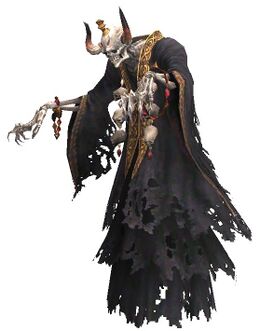Category:Corses: Difference between revisions
| Line 116: | Line 116: | ||
! width="25%"|Level | ! width="25%"|Level | ||
! width="50%"|Zone | ! width="50%"|Zone | ||
|- | |- valign="top" | ||
|[[Corse]] | |[[Corse]] | ||
| align="center" | 66-67 | | align="center" | 66-67 | ||
|[[Attohwa Chasm]] | |[[Attohwa Chasm]] | ||
|- | |- valign="top" | ||
|[[Arch Corse]] | |[[Arch Corse]] | ||
| align="center" | 75-81 | | align="center" | 75-81 | ||
|[[Attohwa Chasm]] | |[[Attohwa Chasm]] | ||
|- | |- valign="top" class="abyssea" | ||
|[[Wiederganger]] | |[[Wiederganger]] | ||
| align="center" | | | align="center" | {{question}} | ||
|[[Abyssea - Tahrongi]] | |[[Abyssea - Tahrongi]] | ||
|} | |} | ||
Latest revision as of 19:00, 9 December 2023
| Corses | ||||||||||||||||||||
|---|---|---|---|---|---|---|---|---|---|---|---|---|---|---|---|---|---|---|---|---|
Not only are Corse able to silence their opponents, but they can even temporarily charm them and force the charmed attacker to instead attack his or her own party members. For this reason alone, all adventurers should be cautious when approaching. To the victors fall a few interesting items. The bracelets and robes worn by the Corse can be picked off of their now twice-defeated bodies. These items can be desynthesized into precious metals and gemstones (in the case of the bracelets) or cloths and threads (in the case of the robes). Of even more interest are the Iolite that all Corse carry. These blue jewels are only found on the Corse, and are an item of some desire by Bluffnix.
| ||||||||||||||||||||
Special Attacks
| Special Abilities | Promathia Areas | Aht Urhgan Areas | Wings of the Goddess Areas | |
| Danse Macabre: Single-target Charm | ||||
| Silence Seal: AoE Silence | ||||
| Memento Mori: Magic Attack Boost | ||||
| Envoutement: Single-target damage, Chance of Curse | ||||
| Gala Macabre: AoE Charm, only used by some notorious monsters | ||||
| Final Retribution: AoE damage and Stun, only used by some notorious monsters | ||||
| Note: Notorious Monsters in this family may use all of the above and/or additional unique special abilities. | ||||
Notorious Monsters in Family
| Name | Spawn Information | Level | Zone | Notable Drop(s) |
|---|---|---|---|---|
| Citipati | Lottery Spawn from the Corse around (F-8) - (F-9) | 67-70 | Attohwa Chasm | Druid's Slops Harpe |
| Xolotl | Timed Spawn around (E-7) approximately every 21 hours at night | 80-81 | Attohwa Chasm | Bandomusha Kote Perseus's Harpe Zoolater Hat |
| Elel | Spawns around (J-8) possibly during Darkness weather at night | Sacrarium | Frenzy Sallet Magical Mitts | |
| Mictlantecuhtli | Timed Spawn around (G-4). Unknown period between spawns. | Abyssea - Tahrongi | Mictlantecuhtli's Habit Serpentes Cuffs | |
|
Quest NMs: None Mission NMs: Keremet Battlefield NMs: Gwyn Ap Knudd (ENM) Campaign NMs: Raigegue R d'Oraguille Other NMs: Andhrimnir (Einherjar - Wing II), Grave Digger (Limbus - SE Apollyon) | ||||
Monsters in Family
| Name | Level | Zone |
|---|---|---|
| Corse | 66-67 | Attohwa Chasm |
| Arch Corse | 75-81 | Attohwa Chasm |
| Wiederganger | Abyssea - Tahrongi |
Historical Background
Corse
Corse is an archaic English word for "corpse". It is derived from the Latin word corpus.
Danse Macabre
Danse Macabre is a Medieval European allegory about death affecting every person, be they peasant, feudal lord, clergyman, or king. The dance of death unites all humans across class strata. Danse Macabre was usually depicted in the form of a painting or engraving (occasionally in the form of a play), showing death in the form of a dancing skeleton leading a line of dancers to the grave, a line which included usually the skeletons of a king or emperor, a pope, a monk, a woman, and a child. The Danse Macabre originated after the Black Death swept through Europe, killing between one-quarter and one-third of the continent's entire population between 1347-1351 CE, when the people realized how easy it was to die and how death could claim anybody. It is also believed the recurrent famines of the 14th & 15th Centuries also contributed to the development of this allegory.
The usage of this concept for a charm spell is linked with its historic background. In the Danse Macabre, Death gains control of the dying, leading them in a dance procession to the afterlife.
Memento Mori
Memento Mori is a Medieval European concept descripting works of art that were intended to remind the viewers of their mortality. Memento Mori is a Latin phrase translated as "remember your mortality", "remember you will die", or "remember your death". These were one of the dominant themes found in Medieval Christian artwork. Medieval Christianity was focused on the afterlife and taught its faithful that the mortal life was fleeting, preparation for the afterlife, and one's actions and conduct in life would lead one to Heaven or Hell. The Church attempted to persuade people to spurn the luxuries of life (called vanities) and live a pious, simple life. The Memento Mori served the purpose of emphasizing how ephemeral and empty "earthly pleasures" are. The typical Memento Mori artwork had a skull in it and some form of vanity (a mirror, a flower), and occasionally an hourglass with sand (to emphasize the limited time). The Danse Macabre is also considered a Memento Mori.
Memento Moris actually date back to the Roman Empire, when during the victory parades (called triumphs) for Roman generals through the streets of Rome, it was coordinated by the parade organizers to have a slave standing behind the general reminding him that he is still a man (and thus subject to changes in the tides of fortune). However, the term Memento Mori was not used to refer to this practice. Memento Mori, before its use in Medieval Europe, had the connotation of live life to the fullest before death, not to contemplate mortality in a somber manner. The Medieval Memento Mori apparently originated from how Europeans viewed the genre of still lifes. Still Life, called Vanitas, in Medieval Europe, normally depicts simple objects, like flowers or a bowl of fruit, but artisans eventually began adding a motif of decay to it (skulls, rotting fruit, or dying flowers). From there, it evolved into the concept recognized as Memento Mori.
Envoutement
Envoutement refers to performing sympathetic magic (creating an image of something in the hopes of making it appear or performing some action on a similacrum in hopes of the real thing being faced with that same action). The most common depiction is of a person performing this magic manipulating a doll or an effigy of a person, putting needles in it or burning it, for example. Envoutement is French for invultuation. Invultuation is the more commonly used term for this concept than envoutement.

